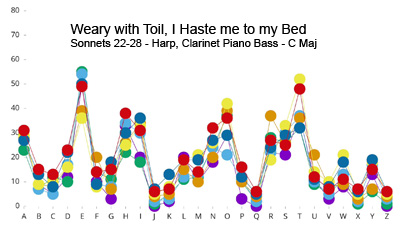The Sonnets
Shakespeare's sonnets are universally recognised as iconic pieces of writing with their themes of mortality, love, infidelity and jealousy critically analysed by erudite scholars. With some sonnets addressed to a young man and others to a mysterious ‘dark lady’, the perfection of this poetry lies in the ambiguity of its meaning and the multitude of interpretations it draws from each reader.
This sound experiment consists of four short pieces. It was presented, together with an animation created by Rainer Lehmann, at Le Salon L'Automne 2024. Each piece is an 'unbinding' of seven sonnets into their component parts, the letters. By forcing mathematical rules upon the frequency that individual letters occurm each sonnet is rebound to create a new 'sound'.
The Rules
The frequency of each letter is used to derive a musical note. A letter count of zero corresponds to C2 (two octaves below 'middle C'). A letter count of 1 corresponds to C2# and for each increase of 1 in the letter count we move up the musical scale by a semitone.
The length of each note is determined by the iambic pentameter with notes alternating in length and loudness. Odd notes are a quarter note and even notes are half-note. All the pieces are in 4/4 time. The start of each track may be offset by several measures or bars to add rhythmic variation and effect harmonies between the instruments.
Each piece utilises the letter counts from seven sonnets. The first uses the letter frequency data from sonnets 1 to 7, the second from sonnets 8 to 14, and so on. The arrangement of each piece is in four parts, for plucked strings and woodwind whereby each sonnet is represented by a different instrument.
Track List




Each sonnet conforms to strict rules, whereby fourteen lines are end-rhymed a-b-a-b, c-d-c-d, e-f-e-f, g-g and written in iambic pentameter, each line consisting of ten syllables. The syllables are divided into five pairs called iambs where one unstressed syllable is followed by one stressed syllable daDUM / daDUM / daDUM / daDUM / daDUM.
The length of each note is determined by the iambic pentameter with notes alternating in length and loudness. Odd notes are a quarter note and even notes are half-note. All the pieces are in 4/4 time. The start of each part may be offset by several measures or bars to add rhythmic variation and effect harmonies between the instruments.
Each piece utilises the letter counts from seven sonnets. The first uses the letter frequency data from sonnets 1 to 7, the second from sonnets 8 to 14, and so on. The arrangement of each piece is in four parts, for plucked strings and woodwind.
Return to Portfolio